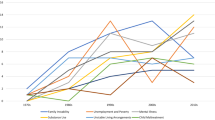Abstract
Federal funding efforts have increased the number of reentry programs over the past decade with corresponding evaluations of these initiatives. Reentry programming targets a wide range of offenders though most have focused on medium and high-risk individuals with substance abuse and/or mental health disorders. This research note provides a profile overview of two programs in central Ohio funded by the Second Chance Act and offers a summary of process and outcome evaluation findings from both initiatives. Results from a mixed methods research design suggested that the programs were largely successful in terms of reducing recidivism among participants, though issues related to programmatic fidelity were also identified. While these programs pre-date more current offender intervention efforts, such as the Justice Mental Health Collaboration Program, identified barriers to program success reaffirm the saliency of longstanding problems embedded in and challenged by correctional and police culture.
Similar content being viewed by others
References
Braga, A. A., Piehl, A. M., & Hureau, D. (2009). Controlling violent offenders released to the community: An evaluation of the Boston reentry initiative. Journal of Research in Crime and Delinquency, 46(4), 411–436.
Colvin, M., Cullen, F. T., & Ven, T. V. (2002). Coercion, social support, and crime: An emerging theoretical consensus. Criminology, 40(1), 19–42.
Cullen, F. T., & Jonson, C. L. (2016). Correctional theory: Context and consequences. Thousand Oaks: Sage Publications.
Gideon, L. (2010). Drug offenders’ perceptions of motivation: The role of motivation in rehabilitation and reintegration. International Journal of Offender Therapy and Comparative Criminology, 54(4), 597–610.
Lattimore, P. K., & Visher, C. (2009). Multi-site evaluation of SVORI: Summary and synthesis. Prepared for the National Institute of Justice. Available from: http://www.urban.org/uploadedpdf/412075_evaluation_svori.pdf
Little, G. L., & Robinson, K. D. (1988). Moral reconation therapy: A systematic step-by-step treatment system for treatment resistant clients. Psychological Reports, 62(1), 135–151.
Lowenkamp, C. T., Latessa, E. J., & Smith, P. (2006). Does correctional program quality really matter? The impact of adhering to the principles of effective intervention. Criminology & Public Policy, 5(3), 575–594.
Lynch, J. P., & Furstenau, C. M. (2008). The Auglaize County transition program. American Jails, 22(5), 1–4.
McKnight, E. R., Bonny, A. E., Lange, H. L., Kline, D. M., Abdel-Rasoul, M., Gay, J. R., & Matson, S. C. (2017). Statewide opioid prescriptions and the prevalence of adolescent opioid misuse in Ohio. The American Journal of Drug and Alcohol Abuse, 43(3), 299–305.
Miethe, T. D., & Lu, H. (2005). Punishment: A comparative historical perspective. Cambridge: Cambridge University Press.
Miller, J. M., Koons-Witt, B. A., & Ventura, H. E. (2004). Barriers to evaluating the effectiveness of drug treatment behind bars. Journal of Criminal Justice, 32(1), 75–83.
Miller, H. V., & Miller, J. M. (2010). Community in-reach through jail reentry: Findings from a quasi-experimental design. Justice Quarterly, 27(6), 893–910.
Miller, J. M., & Miller, H. V. (2015). Rethinking program fidelity for criminal justice. Criminology & Public Policy, 14(2), 339–349.
Miller, J.M., Stogner, J.M., & Miller, B.L. (2017). Exploring synthetic heroin: Accounts of acetyl fentanyl use from a sample of dually-diagnosed drug offenders. Drug & Alcohol Review. https://doi.org/10.1111/dar.12502.
Roozen, H. G., De Waart, R., & Van Der Kroft, P. (2010). Community reinforcement and family training: An effective option to engage treatment-resistant substance-abusing individuals in treatment. Addiction, 105(10), 1729–1738.
Severson, M. E., Bruns, K., Veeh, C., & Lee, J. (2011). Prisoner reentry programming: Who recidivates and when? Journal of Offender Rehabilitation, 50, 327–348.
Shover, N. (1979). A sociology of American corrections. Homewood: Dorsey Press.
Stewart, L., & Picheca, J. C. (2001). Improving offender motivation for programming. Forum on Corrections Research,13(1), 18–20.
Visher, C. A., Lattimore, P. K., Barrick, K., & Tueller, S. (2017). Evaluating the long-term effects of prisoner reentry services on recidivism: What types of services matter? Justice Quarterly, 34(1), 136–165.
Wilson, J. A., & Davis, R. C. (2006). Good intentions meet hard realities: An evaluation of the project greenlight reentry program. Criminology & Public Policy, 5, 303–338.
Acknowledgements
This project was sponsored by Grants Nos. 2011-RW-BX-0008 and 2011-RN-BX0004 awarded by the US Bureau of Justice Assistance, Office of Justice Programs, U.S. Department of Justice. Points of view in this document are those of the authors and do not necessarily represent the official position or policies of the Delaware County (OH) Sheriff’s Office or the U.S. Department of Justice.
Author information
Authors and Affiliations
Corresponding author
Rights and permissions
About this article
Cite this article
Mitchell Miller, J., Barnes, J.C. & Miller, H.V. Profile of Two Second Chance Act Offender Treatment Initiatives: A Research Note. Am J Crim Just 42, 759–767 (2017). https://doi.org/10.1007/s12103-017-9405-7
Received:
Accepted:
Published:
Issue Date:
DOI: https://doi.org/10.1007/s12103-017-9405-7



